William J. Beksi
Secrets of Edge-Informed Contrast Maximization for Event-Based Vision
Sep 22, 2024Abstract:Event cameras capture the motion of intensity gradients (edges) in the image plane in the form of rapid asynchronous events. When accumulated in 2D histograms, these events depict overlays of the edges in motion, consequently obscuring the spatial structure of the generating edges. Contrast maximization (CM) is an optimization framework that can reverse this effect and produce sharp spatial structures that resemble the moving intensity gradients by estimating the motion trajectories of the events. Nonetheless, CM is still an underexplored area of research with avenues for improvement. In this paper, we propose a novel hybrid approach that extends CM from uni-modal (events only) to bi-modal (events and edges). We leverage the underpinning concept that, given a reference time, optimally warped events produce sharp gradients consistent with the moving edge at that time. Specifically, we formalize a correlation-based objective to aid CM and provide key insights into the incorporation of multiscale and multireference techniques. Moreover, our edge-informed CM method yields superior sharpness scores and establishes new state-of-the-art event optical flow benchmarks on the MVSEC, DSEC, and ECD datasets.
Semi-Supervised Variational Adversarial Active Learning via Learning to Rank and Agreement-Based Pseudo Labeling
Aug 23, 2024



Abstract:Active learning aims to alleviate the amount of labor involved in data labeling by automating the selection of unlabeled samples via an acquisition function. For example, variational adversarial active learning (VAAL) leverages an adversarial network to discriminate unlabeled samples from labeled ones using latent space information. However, VAAL has the following shortcomings: (i) it does not exploit target task information, and (ii) unlabeled data is only used for sample selection rather than model training. To address these limitations, we introduce novel techniques that significantly improve the use of abundant unlabeled data during training and take into account the task information. Concretely, we propose an improved pseudo-labeling algorithm that leverages information from all unlabeled data in a semi-supervised manner, thus allowing a model to explore a richer data space. In addition, we develop a ranking-based loss prediction module that converts predicted relative ranking information into a differentiable ranking loss. This loss can be embedded as a rank variable into the latent space of a variational autoencoder and then trained with a discriminator in an adversarial fashion for sample selection. We demonstrate the superior performance of our approach over the state of the art on various image classification and segmentation benchmark datasets.
Few-Shot Fruit Segmentation via Transfer Learning
May 04, 2024Abstract:Advancements in machine learning, computer vision, and robotics have paved the way for transformative solutions in various domains, particularly in agriculture. For example, accurate identification and segmentation of fruits from field images plays a crucial role in automating jobs such as harvesting, disease detection, and yield estimation. However, achieving robust and precise infield fruit segmentation remains a challenging task since large amounts of labeled data are required to handle variations in fruit size, shape, color, and occlusion. In this paper, we develop a few-shot semantic segmentation framework for infield fruits using transfer learning. Concretely, our work is aimed at addressing agricultural domains that lack publicly available labeled data. Motivated by similar success in urban scene parsing, we propose specialized pre-training using a public benchmark dataset for fruit transfer learning. By leveraging pre-trained neural networks, accurate semantic segmentation of fruit in the field is achieved with only a few labeled images. Furthermore, we show that models with pre-training learn to distinguish between fruit still on the trees and fruit that have fallen on the ground, and they can effectively transfer the knowledge to the target fruit dataset.
A Human-Centered Approach for Bootstrapping Causal Graph Creation
Mar 03, 2024Abstract:Causal inference, a cornerstone in disciplines such as economics, genomics, and medicine, is increasingly being recognized as fundamental to advancing the field of robotics. In particular, the ability to reason about cause and effect from observational data is crucial for robust generalization in robotic systems. However, the construction of a causal graphical model, a mechanism for representing causal relations, presents an immense challenge. Currently, a nuanced grasp of causal inference, coupled with an understanding of causal relationships, must be manually programmed into a causal graphical model. To address this difficulty, we present initial results towards a human-centered augmented reality framework for creating causal graphical models. Concretely, our system bootstraps the causal discovery process by involving humans in selecting variables, establishing relationships, performing interventions, generating counterfactual explanations, and evaluating the resulting causal graph at every step. We highlight the potential of our framework via a physical robot manipulator on a pick-and-place task.
NTrack: A Multiple-Object Tracker and Dataset for Infield Cotton Boll Counting
Dec 18, 2023Abstract:In agriculture, automating the accurate tracking of fruits, vegetables, and fiber is a very tough problem. The issue becomes extremely challenging in dynamic field environments. Yet, this information is critical for making day-to-day agricultural decisions, assisting breeding programs, and much more. To tackle this dilemma, we introduce NTrack, a novel multiple object tracking framework based on the linear relationship between the locations of neighboring tracks. NTrack computes dense optical flow and utilizes particle filtering to guide each tracker. Correspondences between detections and tracks are found through data association via direct observations and indirect cues, which are then combined to obtain an updated observation. Our modular multiple object tracking system is independent of the underlying detection method, thus allowing for the interchangeable use of any off-the-shelf object detector. We show the efficacy of our approach on the task of tracking and counting infield cotton bolls. Experimental results show that our system exceeds contemporary tracking and cotton boll-based counting methods by a large margin. Furthermore, we publicly release the first annotated cotton boll video dataset to the research community.
IPVNet: Learning Implicit Point-Voxel Features for Open-Surface 3D Reconstruction
Nov 05, 2023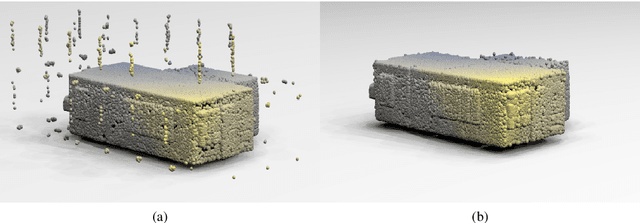

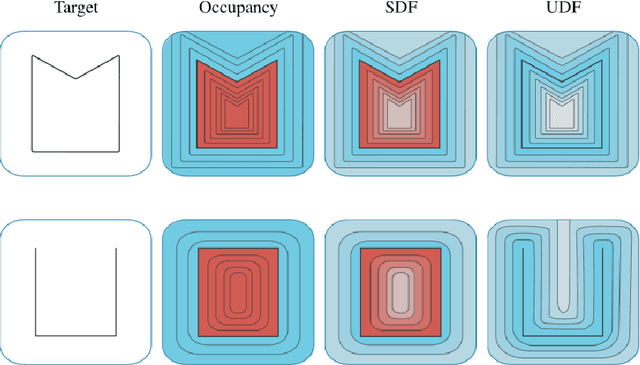

Abstract:Reconstruction of 3D open surfaces (e.g., non-watertight meshes) is an underexplored area of computer vision. Recent learning-based implicit techniques have removed previous barriers by enabling reconstruction in arbitrary resolutions. Yet, such approaches often rely on distinguishing between the inside and outside of a surface in order to extract a zero level set when reconstructing the target. In the case of open surfaces, this distinction often leads to artifacts such as the artificial closing of surface gaps. However, real-world data may contain intricate details defined by salient surface gaps. Implicit functions that regress an unsigned distance field have shown promise in reconstructing such open surfaces. Nonetheless, current unsigned implicit methods rely on a discretized representation of the raw data. This not only bounds the learning process to the representation's resolution, but it also introduces outliers in the reconstruction. To enable accurate reconstruction of open surfaces without introducing outliers, we propose a learning-based implicit point-voxel model (IPVNet). IPVNet predicts the unsigned distance between a surface and a query point in 3D space by leveraging both raw point cloud data and its discretized voxel counterpart. Experiments on synthetic and real-world public datasets demonstrates that IPVNet outperforms the state of the art while producing far fewer outliers in the resulting reconstruction.
CitDet: A Benchmark Dataset for Citrus Fruit Detection
Sep 11, 2023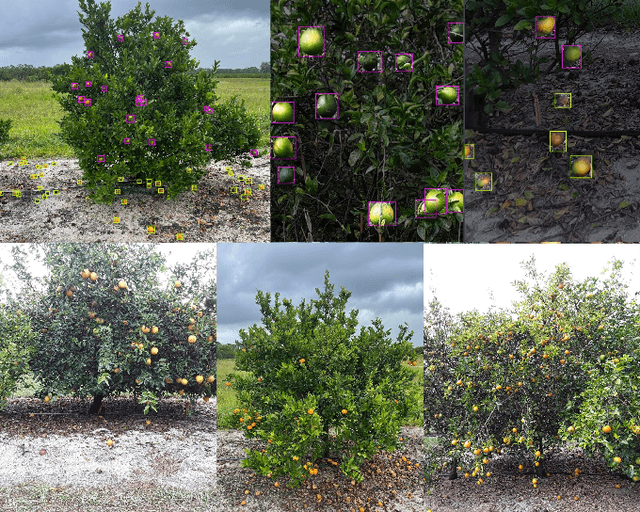
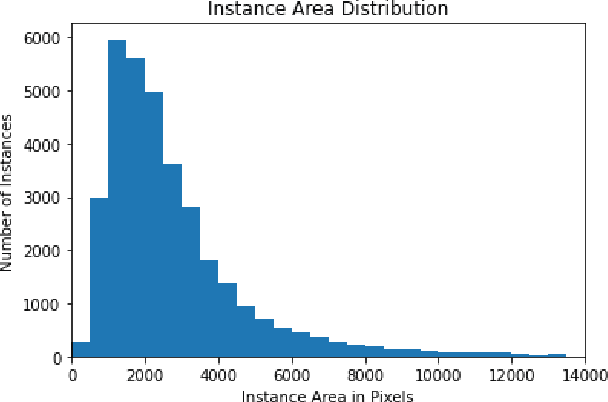
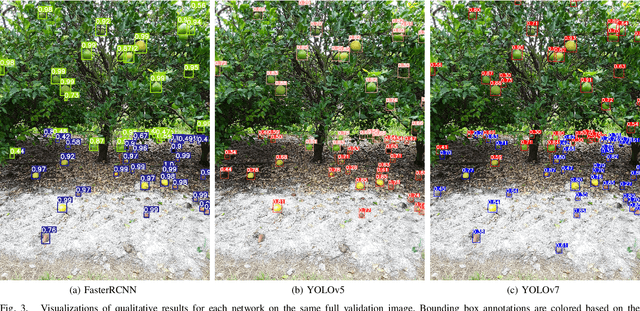

Abstract:In this letter, we present a new dataset to advance the state of the art in detecting citrus fruit and accurately estimate yield on trees affected by the Huanglongbing (HLB) disease in orchard environments via imaging. Despite the fact that significant progress has been made in solving the fruit detection problem, the lack of publicly available datasets has complicated direct comparison of results. For instance, citrus detection has long been of interest in the agricultural research community, yet there is an absence of work, particularly involving public datasets of citrus affected by HLB. To address this issue, we enhance state-of-the-art object detection methods for use in typical orchard settings. Concretely, we provide high-resolution images of citrus trees located in an area known to be highly affected by HLB, along with high-quality bounding box annotations of citrus fruit. Fruit on both the trees and the ground are labeled to allow for identification of fruit location, which contributes to advancements in yield estimation and potential measure of HLB impact via fruit drop. The dataset consists of over 32,000 bounding box annotations for fruit instances contained in 579 high-resolution images. In summary, our contributions are the following: (i) we introduce a novel dataset along with baseline performance benchmarks on multiple contemporary object detection algorithms, (ii) we show the ability to accurately capture fruit location on tree or on ground, and finally (ii) we present a correlation of our results with yield estimations.
LIST: Learning Implicitly from Spatial Transformers for Single-View 3D Reconstruction
Jul 23, 2023



Abstract:Accurate reconstruction of both the geometric and topological details of a 3D object from a single 2D image embodies a fundamental challenge in computer vision. Existing explicit/implicit solutions to this problem struggle to recover self-occluded geometry and/or faithfully reconstruct topological shape structures. To resolve this dilemma, we introduce LIST, a novel neural architecture that leverages local and global image features to accurately reconstruct the geometric and topological structure of a 3D object from a single image. We utilize global 2D features to predict a coarse shape of the target object and then use it as a base for higher-resolution reconstruction. By leveraging both local 2D features from the image and 3D features from the coarse prediction, we can predict the signed distance between an arbitrary point and the target surface via an implicit predictor with great accuracy. Furthermore, our model does not require camera estimation or pixel alignment. It provides an uninfluenced reconstruction from the input-view direction. Through qualitative and quantitative analysis, we show the superiority of our model in reconstructing 3D objects from both synthetic and real-world images against the state of the art.
Intuitive Robot Integration via Virtual Reality Workspaces
May 25, 2023Abstract:As robots become increasingly prominent in diverse industrial settings, the desire for an accessible and reliable system has correspondingly increased. Yet, the task of meaningfully assessing the feasibility of introducing a new robotic component, or adding more robots into an existing infrastructure, remains a challenge. This is due to both the logistics of acquiring a robot and the need for expert knowledge in setting it up. In this paper, we address these concerns by developing a purely virtual simulation of a robotic system. Our proposed framework enables natural human-robot interaction through a visually immersive representation of the workspace. The main advantages of our approach are the following: (i) independence from a physical system, (ii) flexibility in defining the workspace and robotic tasks, and (iii) an intuitive interaction between the operator and the simulated environment. Not only does our system provide an enhanced understanding of 3D space to the operator, but it also encourages a hands-on way to perform robot programming. We evaluate the effectiveness of our method in applying novel automation assignments by training a robot in virtual reality and then executing the task on a real robot.
MetaMax: Improved Open-Set Deep Neural Networks via Weibull Calibration
Nov 20, 2022Abstract:Open-set recognition refers to the problem in which classes that were not seen during training appear at inference time. This requires the ability to identify instances of novel classes while maintaining discriminative capability for closed-set classification. OpenMax was the first deep neural network-based approach to address open-set recognition by calibrating the predictive scores of a standard closed-set classification network. In this paper we present MetaMax, a more effective post-processing technique that improves upon contemporary methods by directly modeling class activation vectors. MetaMax removes the need for computing class mean activation vectors (MAVs) and distances between a query image and a class MAV as required in OpenMax. Experimental results show that MetaMax outperforms OpenMax and is comparable in performance to other state-of-the-art approaches.
 Add to Chrome
Add to Chrome Add to Firefox
Add to Firefox Add to Edge
Add to Edge